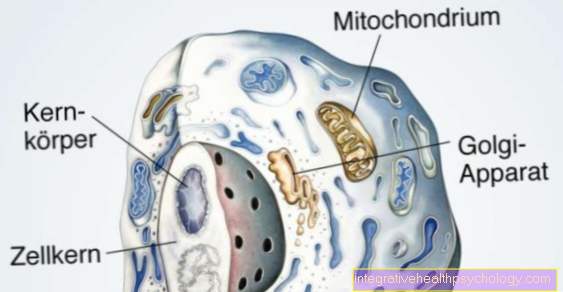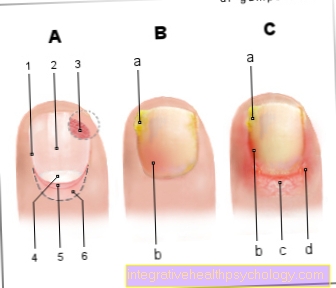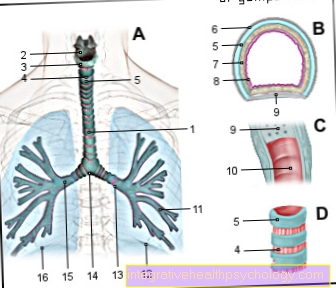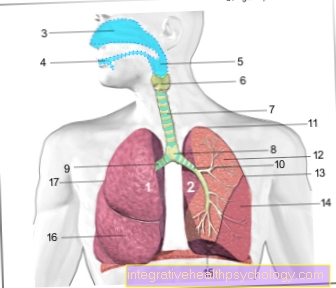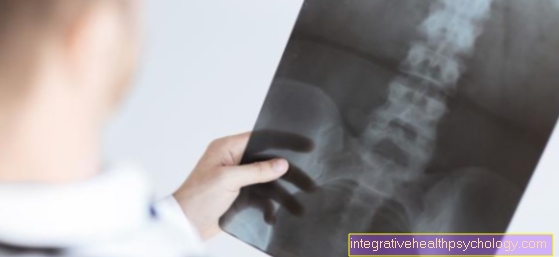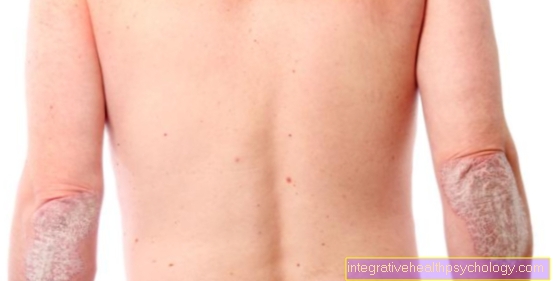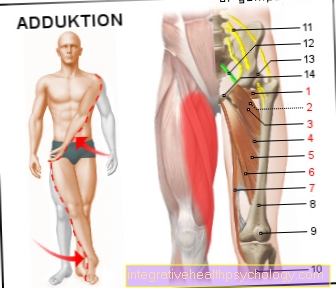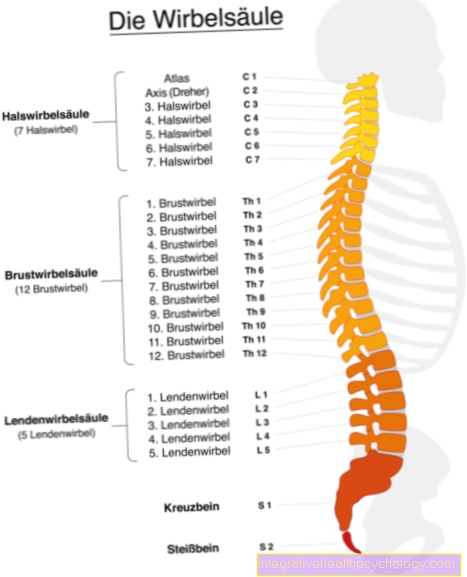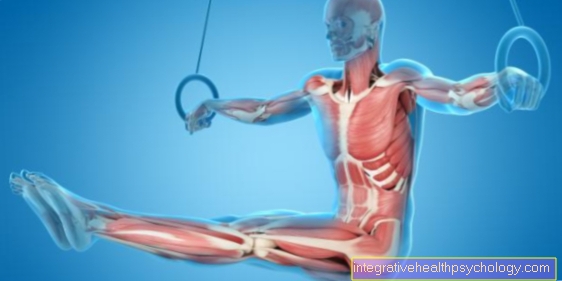Pneumonia pain
introduction
Typical pneumonia is often accompanied by a range of symptoms. In addition to the classic symptoms of cough, fever and fatigue, there are also all kinds of pain. The spectrum ranges from classic limb pain, which everyone has probably already experienced, to breathing-dependent pain in the rib area to chest pain. While some of these types of pain are harmless and go away, others need to be taken seriously and can provide clues to pneumonia complications.

This is what the pain feels like with pneumonia
Since very different types of pain can occur in the context of pneumonia, the perception of this is also very different. A rather harmless, if perceived as very annoying pain is the classic limb pain. This results in dull pain in muscles and joints. The pain can be felt both at rest and when moving and is often particularly severe in the form of an increase in fever.
In addition to pain of this kind, breathing-dependent pain or pain when coughing can occur, especially with prolonged coughing. This is often a stabbing or tearing pain that can be felt around the entire chest. In the case of frequent and strong coughing, muscle soreness can also occur in the abdominal and chest muscles, which then typically begins during the cough and is also tearing or stabbing in character. This pain can also be provoked by applying pressure to the affected muscles.
Read more on this topic at: Symptoms of pneumonia
Back pain
Back pain is a relatively common phenomenon in pneumonia. These can have various causes. Often the entire back muscles ache as the fever rises. Then it is the classic limb and muscle pain. These are not dangerous, but still annoying. As the fever drops, the pain often subsides again. Otherwise, pain reliever medications such as ibuprofen and paracetamol will help. These also lower the fever at the same time.
Another cause of back pain can be pleura involvement. This is often the case with advanced pneumonia. Then typical breath-dependent pain appears, which can be felt both during inhalation and exhalation. The doctor can also hear the typical creaking noises associated with this phenomenon. If you have this type of pain and suspect additional pleurisy, a doctor's visit is necessary. The doctor will decide how to proceed.
A more harmless reason for back pain during pneumonia can be lying on your back for too long. Occasional standing up and sitting is helpful. Changing the lying position can also help.
Read more on this topic at:
- pleurisy
- Causes of back pain
Chest pain
Pain can also occur in the chest, especially with advanced pneumonia. These can be continuous and take on a burning character. Such pain may be due to the constant irritation of the windpipe from coughing. If the pain becomes very severe or recurs, a doctor should be consulted again. Breath-dependent pain can also occur in the chest area.
If the pain only occurs during inhalation and if you hold your breath briefly after inhaling, then it is usually a harmless muscular cause. Such pain is usually sharp and similar to sore muscles. It comes from overloading the respiratory muscles due to the frequent coughing. Occasionally, a pinched nerve can also be the cause. Usually this pain is not so severe that it requires treatment. If necessary, however, pain medication can also be used.
If the pain occurs not only when you breathe in but also when you breathe out, it may be pleurisy. The above-described holding of breath after inhalation is usually painless and represents an important differentiating criterion. If pleurisy is suspected, a new doctor's visit is required. In the case of any sudden severe pain in the chest area, especially with radiation to other parts of the body and shortness of breath, a doctor should be consulted immediately or an ambulance should be alerted, as it can of course always be a heart condition regardless of pneumonia.
Read more on this topic at:
- Consequences of pneumonia
- Chest pain
Pain under the costal arch
Pain under the costal arch can occur, especially if you have a strong cough caused by pneumonia. These take on a tearing and sometimes stinging character. Pain in this area can occur both breath-dependent and continuously or movement-dependent. Continuous or movement-dependent pain is usually harmless and is a sign of an overload of the muscles that start in the area of the costal arch.
Smaller entrapment of the rib nerves is also particularly common in this area. These show up in the same symptoms. Pain of this kind is uncomfortable, but usually goes away on its own after a while. If necessary, mild pain relievers can be taken, e.g. Ibuprofen or paracetamol. Breath-dependent pain can also have the same harmless cause. In some cases, however, an inflammation of the pleura can also be the cause. More details are given in the section entitled “Chest pain”.
Read more on this topic at:
- Pain in the costal arch
- Pain in the costal arch from coughing
Shoulder pain
Shoulder pain can have several causes. Often, particularly with bilateral pain, it is simply harmless pain in the limbs, as it often occurs in pneumonia with fever. If necessary, this can be treated with painkillers. Ibuprofen or paracetamol, for example, are suitable for this. In addition to this rather harmless cause, pleurisy can also be the reason for the pain.
Pleurisy can occur as a concomitant disease with pneumonia, but also with bronchitis. Violent breath-dependent pain occurs mainly in the initial stage, in the so-called dry form. Later this can change into the moist form. Then the breath-dependent pain subsides because the skins of the fur no longer rub against each other, but the increasingly fluid that forms can cause problems. This fluid is called a pleural effusion, it can displace the lungs, make breathing difficult, and also irritate the diaphragmatic nerve, which can lead to shoulder pain. If this cause of shoulder pain is suspected, a doctor should be consulted as soon as possible to discuss how to proceed.
Read more on this topic at: Shoulder pain
Pain when coughing
Pain when coughing is a relatively common phenomenon in the context of pneumonia. It occurs particularly when coughing has been around for a long time. The pain can occur deep in the throat or in the chest. Then it is often an irritation of the mucous membranes in the throat and windpipe. Pain can also occur in the area of the ribs and stomach during the cough. These are mostly muscular and are an expression of the unusual muscle exertion. If the pain is severe, painkillers can also be taken here.
Read more on this topic at: Pain when coughing
Rib pain
Pain in or between the ribs is often muscular pain. If you cough for a long time, the muscles between the ribs are heavily and unusually stressed. This causes symptoms of fatigue, which show up in the form of sore muscles. A pinched nerve can also trigger the pain. These forms of pain are harmless and usually do not require any treatment. However, pain in the ribs when inhaling and exhaling can again indicate pleurisy. Then a doctor should be consulted again.
Read more on this topic at:
- Rib pain - these are the causes
- Rib pain when coughing
Pain in the diaphragm
Pain in the abdominal area near the diaphragm can also be an expression of muscular overload caused by persistent coughing. The diaphragm is the largest and most important respiratory muscle that is stressed in an unusual way when coughing. This pain is harmless. However, pressure in the area of the diaphragm can also arise from a pleural effusion when fluid forms between the membranes of the pleura. If the diaphragm is also affected by pleurisy, hiccups can also occur.
Read more on this topic at: Pain in the diaphragm
Pain between the shoulder blades
Pain can also occur between the shoulder blades during pneumonia. These are often intensified during breathing and then again provide an indication of the pleurisy mentioned above. But simple body aches can also occur in this area. In addition, the muscles of the back in this area can also be affected by strong coughing and therefore pain. In the latter two cases, no additional treatment is required, but pain medication can be used if necessary.
Read more about this topic at: Pain between the shoulder blades
How can you relieve the pain?
Many types of pain, especially those that are muscular, can be significantly alleviated with a mild pain reliever. The pain in the limbs in particular, which can appear in many different parts of the body, is so good to treat. If there is also a high fever, this type of pain often improves as the body temperature drops. Pain in the throat, throat, and windpipe from irritated mucous membranes can be treated with herbal medicines. These are available from the pharmacy.
The active ingredients protect the irritated mucous membrane and relieve the irritation of the throat. With constant irritable cough, cough suppressants can suppress the stimulus and thus give the mucous membrane space to regenerate. However, cough suppressants must never be taken in parallel with expectorants, otherwise the mucus will remain in the lungs. Pain associated with pleurisy can also be treated with pain relievers. In this case, however, a renewed visit to the doctor is necessary in order to discuss the exact treatment, possibly also a hospital admission.
Read more on this topic at:
- Painkiller
- Cough medication
- NSAIDs
Duration of pain
The duration of the pain can be very variable depending on the trigger. Pain in the limbs usually only persists for a few days as part of pneumonia. The healing of pleurisy and the associated pain when breathing can take a long time, depending on the severity of the disease and the structures involved. Muscle pain in the stomach, back and between the ribs often goes away after a few days, especially when the cough subsides and the muscles can relax.
Read more on this topic at: How long does pneumonia last?


